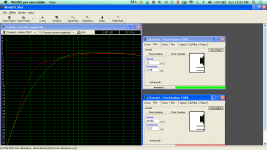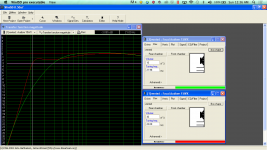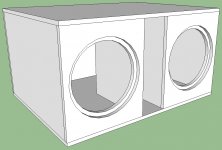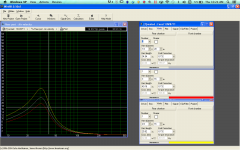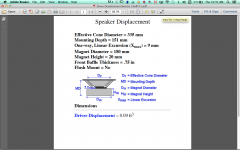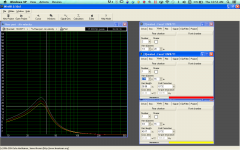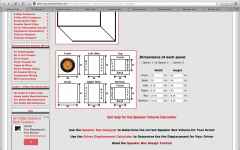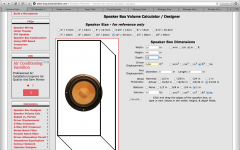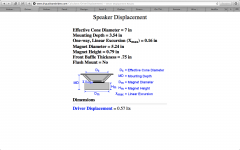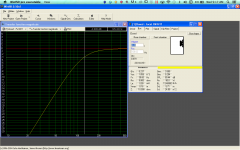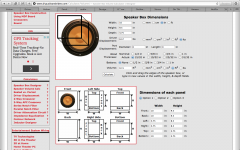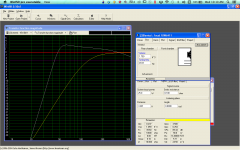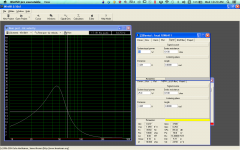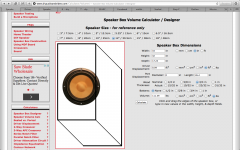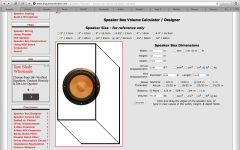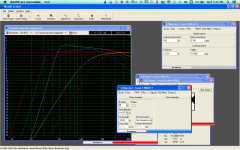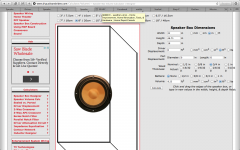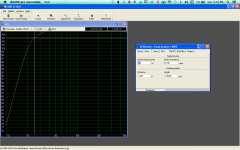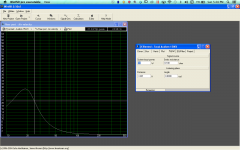Your ears determine the location of a sound by the diffraction around your head. How articulate do you think your phase discrimination powers are? Much better than any computer and microphone.
There are psychological factors at play here gentlemen. Numbers are only the starting point.
Art is a matter of feeling and experiencing, not measuring. Acoustics is the marriage of art and science.
What makes something sound good is as much subjective as it is analytically derived.
You can measure frequency response all you want, but in the end it may just sound better if you add or reduce some component of the spectrum.
Or if you alter a time domain relationship between two drivers.
When a concert hall is designed there is no specific value for reverberation time. It is chosen based on subjective interoperation, from a range of values. Without some listening and adjustment you will never have the best sound.
There are psychological factors at play here gentlemen. Numbers are only the starting point.
Art is a matter of feeling and experiencing, not measuring. Acoustics is the marriage of art and science.
What makes something sound good is as much subjective as it is analytically derived.
You can measure frequency response all you want, but in the end it may just sound better if you add or reduce some component of the spectrum.
Or if you alter a time domain relationship between two drivers.
When a concert hall is designed there is no specific value for reverberation time. It is chosen based on subjective interoperation, from a range of values. Without some listening and adjustment you will never have the best sound.
Last edited:
It also may not occur to you that a single driver does not emit sound in phase even from itself.
The oscillating body is not entirely rigid and portions of the body oscillate out of phase with each other, and that the phase relationship varies with frequency.
So which portion of the oscillator and at which frequency do you calculate to align the next driver with ?
Your measurements will sort that problem out though right?
Oh wait a minute I can just listen to it and vary it gradually until it sounds right.
But you would never think to do that because its not humanly possible right?
The oscillating body is not entirely rigid and portions of the body oscillate out of phase with each other, and that the phase relationship varies with frequency.
So which portion of the oscillator and at which frequency do you calculate to align the next driver with ?
Your measurements will sort that problem out though right?
Oh wait a minute I can just listen to it and vary it gradually until it sounds right.
But you would never think to do that because its not humanly possible right?
Last edited:
I guess I didn't mention that I will do some measuring .
You guys must think Im crazy lol.
🙂
That's all I wanted to hear. So, you are not that unreasonable.

So hears my new crazy idea. I am considering stacking the two cabinets together and joining them to form one cabinet of 20cu ft and putting both 15wx woofers inside.
This changes things from about -8db at 25hz, to about -3.5.
hmmmmmm Could be worth while.
Another thing I may do is build the bass port into the cavity that will join the two separate boxes. So that the port volume will not reduce the volume of the existing cabinet. This will make it easier to simulate and calculate more accurately the tuning. Avoiding the iterative process of subtracting the port volume from the box, and devising a new port tuning on and on indefinitely, I will avoid this process this way.
It will be a T shape joining the two cavities, the new volume will be the old box volume doubled plus the joining portion of the T, and the rest of the T will be the bass port.
This changes things from about -8db at 25hz, to about -3.5.
hmmmmmm Could be worth while.
Another thing I may do is build the bass port into the cavity that will join the two separate boxes. So that the port volume will not reduce the volume of the existing cabinet. This will make it easier to simulate and calculate more accurately the tuning. Avoiding the iterative process of subtracting the port volume from the box, and devising a new port tuning on and on indefinitely, I will avoid this process this way.
It will be a T shape joining the two cavities, the new volume will be the old box volume doubled plus the joining portion of the T, and the rest of the T will be the bass port.
Attachments
For the 13w8711 considering minimum port opening area to avoid chuffing noise I have run a simulation with win ISD, but also calculated the minimum port area.
"For vented type speakers operated at full power that is, full excursion, it is possible to end up with audible noise from the air rushing in and out of the vent. For a given speaker system, the smaller the vent opening the greater the velocity of air in the vent and the greater the vent noise. Small wanted to know what the smallest vent area was that would be free from this noise. In the above paper Small states that based on listening tests he determined the maximum air velocity which avoids excessive noise generation is about 5% of the speed of sound. This is provided that the inside surface of the vent is smooth and that the edges of the vent are rounded off to a "reasonable radius". Small came up with an approximate formula which limits the velocity of sound in the port to 4.5% of the speed of sound for a wide range of vented box alignments. The formula he gave is as follows:
S(V) >= 0.8 * f(B) * V(D) (read ">=" as greater than or equal to)
where the area of the vent, S(V), is in square meters, and the peak volume displacement of the cone, V(D), is in cubic meters. After converting S(V) to square inches and V(D) to cubic inches this formula becomes
S(V) >= 0.02032 * f(B) * V(D) "
from
- https://www.trueaudio.com/st_ventq.htm
so for my application of 13w8711
xmax of 0.35 inches
Sd 85.5 in^2
Vd=0.35(85.5) inches^3
Vd=29.925 inches^3
S(v)= 20.4921inches ^2
This more or less confirms the port velocity I get from win ISD at 100 w.
"For vented type speakers operated at full power that is, full excursion, it is possible to end up with audible noise from the air rushing in and out of the vent. For a given speaker system, the smaller the vent opening the greater the velocity of air in the vent and the greater the vent noise. Small wanted to know what the smallest vent area was that would be free from this noise. In the above paper Small states that based on listening tests he determined the maximum air velocity which avoids excessive noise generation is about 5% of the speed of sound. This is provided that the inside surface of the vent is smooth and that the edges of the vent are rounded off to a "reasonable radius". Small came up with an approximate formula which limits the velocity of sound in the port to 4.5% of the speed of sound for a wide range of vented box alignments. The formula he gave is as follows:
S(V) >= 0.8 * f(B) * V(D) (read ">=" as greater than or equal to)
where the area of the vent, S(V), is in square meters, and the peak volume displacement of the cone, V(D), is in cubic meters. After converting S(V) to square inches and V(D) to cubic inches this formula becomes
S(V) >= 0.02032 * f(B) * V(D) "
from
- https://www.trueaudio.com/st_ventq.htm
so for my application of 13w8711
xmax of 0.35 inches
Sd 85.5 in^2
Vd=0.35(85.5) inches^3
Vd=29.925 inches^3
S(v)= 20.4921inches ^2
This more or less confirms the port velocity I get from win ISD at 100 w.
Last edited:
Square ports will be added to the cabinet outside the box volume to simplify things. This will also add a layer of wood and add mass which is always welcome.
To get a port with low enough air velocity this cabinet will have to be long, and shallow, and the port may be longer than the box.
With a port of 2.75 " x 16" x about 36
I get around 17m/s at 100 w at close to 35hz.
To get a port with low enough air velocity this cabinet will have to be long, and shallow, and the port may be longer than the box.
With a port of 2.75 " x 16" x about 36
I get around 17m/s at 100 w at close to 35hz.
Attachments
OK moving on to the 8 inch driver.
I am using 7w6451
I have some recommendations from the seller about the cabinet being best at 0.15 cu ft. Sealed. This is small!
Utopia Sandwich Cone
Cast aluminum basket with spider vent
Rubber surround
Fs = 39.6
Vas = 30 liter
Qts = 0.237
Qms = 3.5
Qes =0.254
Re = 9.8 ohm
Le = 0.5 mH
Mms = 18.9 gram
Sd = 158 cm^2
Xmax = 4 mm
Voice coil length = 14 mm
Top plate thickness = 6 mm
Voice coil Diameter = 40 mm
BL = 13.46
Magnet = 133 mm diameter x 20 mm thick
N0 = 0.724
Efficiency = 90.6 dB
Sensitivity = 89 dB 2.83 V @ 1 meter
Power = 100 watt
Cabinet hole = 165 mm
Basket Diameter = 200 mm
Mounting depth = 90 mm
Optimum Sealed box 0 0.15 cubic foot
-3 dB = 111 Hz
Optimum Vented Box = 0.21 cubic foot
-3dB = 78 Hz
Vent = 61 Hz
Tube = 3 inch diameter x 20 inch
Extended bass shelf = 0.50 cubic foot
-3dB = 56 Hz
Vent = 54 Hz
Tube = 3 inch diameter x 10 inch
When I plot in WIN ISD I get a slightly higher -3db point at 125 hz. In any case the response is optimal at this cabinet volume.
I am using 7w6451
I have some recommendations from the seller about the cabinet being best at 0.15 cu ft. Sealed. This is small!
Utopia Sandwich Cone
Cast aluminum basket with spider vent
Rubber surround
Fs = 39.6
Vas = 30 liter
Qts = 0.237
Qms = 3.5
Qes =0.254
Re = 9.8 ohm
Le = 0.5 mH
Mms = 18.9 gram
Sd = 158 cm^2
Xmax = 4 mm
Voice coil length = 14 mm
Top plate thickness = 6 mm
Voice coil Diameter = 40 mm
BL = 13.46
Magnet = 133 mm diameter x 20 mm thick
N0 = 0.724
Efficiency = 90.6 dB
Sensitivity = 89 dB 2.83 V @ 1 meter
Power = 100 watt
Cabinet hole = 165 mm
Basket Diameter = 200 mm
Mounting depth = 90 mm
Optimum Sealed box 0 0.15 cubic foot
-3 dB = 111 Hz
Optimum Vented Box = 0.21 cubic foot
-3dB = 78 Hz
Vent = 61 Hz
Tube = 3 inch diameter x 20 inch
Extended bass shelf = 0.50 cubic foot
-3dB = 56 Hz
Vent = 54 Hz
Tube = 3 inch diameter x 10 inch
When I plot in WIN ISD I get a slightly higher -3db point at 125 hz. In any case the response is optimal at this cabinet volume.
Attachments
Last edited:
I had the opportunity to grab a bunch of sub cabinets for a reasonable price from empty car sub boxes. Instead of building all these cabinets I got similar volumes of carpeted car sub boxes. I know... I know they look bad. But most of these cabinets are going behind a projector screen to save space anyway.
Later I will add another layer of box on top of the existing box to add mass. The carpeting will become a welcome layer in between the first and second box, dampening some vibration through absorption. This is something I planned on doing anyway, but had not made up my mind on what material to use in between cabinets.
The cabinets I got for the 10w woofer just happened to be 1.75 cu ft, tuned to 50hz with a nice slotted port.
I am going to try with this configuration, and also make a second faceplate to interchange which covers the slotted port. Then I can listen with a sealed 10w in the final speaker .
Later I will add another layer of box on top of the existing box to add mass. The carpeting will become a welcome layer in between the first and second box, dampening some vibration through absorption. This is something I planned on doing anyway, but had not made up my mind on what material to use in between cabinets.
The cabinets I got for the 10w woofer just happened to be 1.75 cu ft, tuned to 50hz with a nice slotted port.
I am going to try with this configuration, and also make a second faceplate to interchange which covers the slotted port. Then I can listen with a sealed 10w in the final speaker .
Attachments
so the box I picked up for the 13w is
32 x 16 x 17.25 = 8832 in^3
=144.7L
Without correcting for baffle thickness. Thumbnail attached shows correction.
but part of the box is trapezoidal subtracted from this volume. (its not square)
The short side in the depth is 14"
the volume of the missing section ( corrected for the thickness of the walls) is
(32-0.75) x (3.25-0.75)( 16-0.75) x 0.5 =
=31.25(2.5)(15.25)(0.5)
=595.703 in^3
=9.75 L
32 x 16 x 17.25 = 8832 in^3
=144.7L
Without correcting for baffle thickness. Thumbnail attached shows correction.
but part of the box is trapezoidal subtracted from this volume. (its not square)
The short side in the depth is 14"
the volume of the missing section ( corrected for the thickness of the walls) is
(32-0.75) x (3.25-0.75)( 16-0.75) x 0.5 =
=31.25(2.5)(15.25)(0.5)
=595.703 in^3
=9.75 L
Attachments
I have one ten and one 15 hooked up and it sounds amazing Hahahah. I have way over done it this time lol 😉
So interestingly despite what the graphs show , when listening to movies or music I can't hear any port noise with the existing configuration.
two 4" Diameter ports per cabinet 13" long for 22 hz tuning
I guess its a testament to the real working range of sound (meaning not much exists sub 30 hz) in most program material.
two 4" Diameter ports per cabinet 13" long for 22 hz tuning
I guess its a testament to the real working range of sound (meaning not much exists sub 30 hz) in most program material.
Attachments
- Status
- Not open for further replies.
- Home
- Loudspeakers
- Multi-Way
- Focal Newform Utopia
